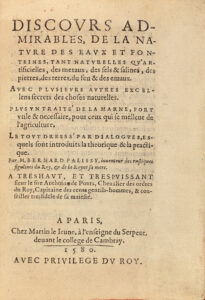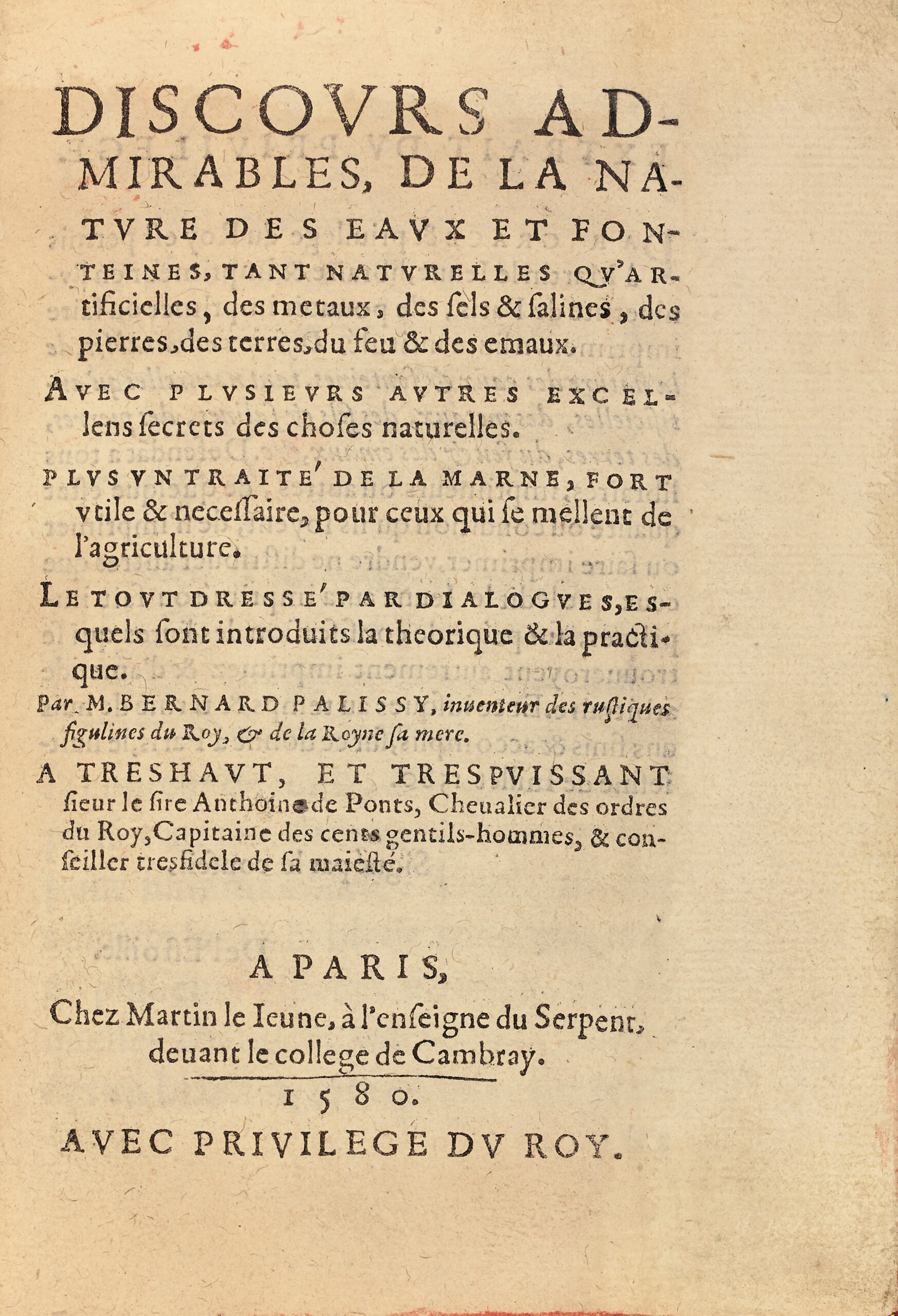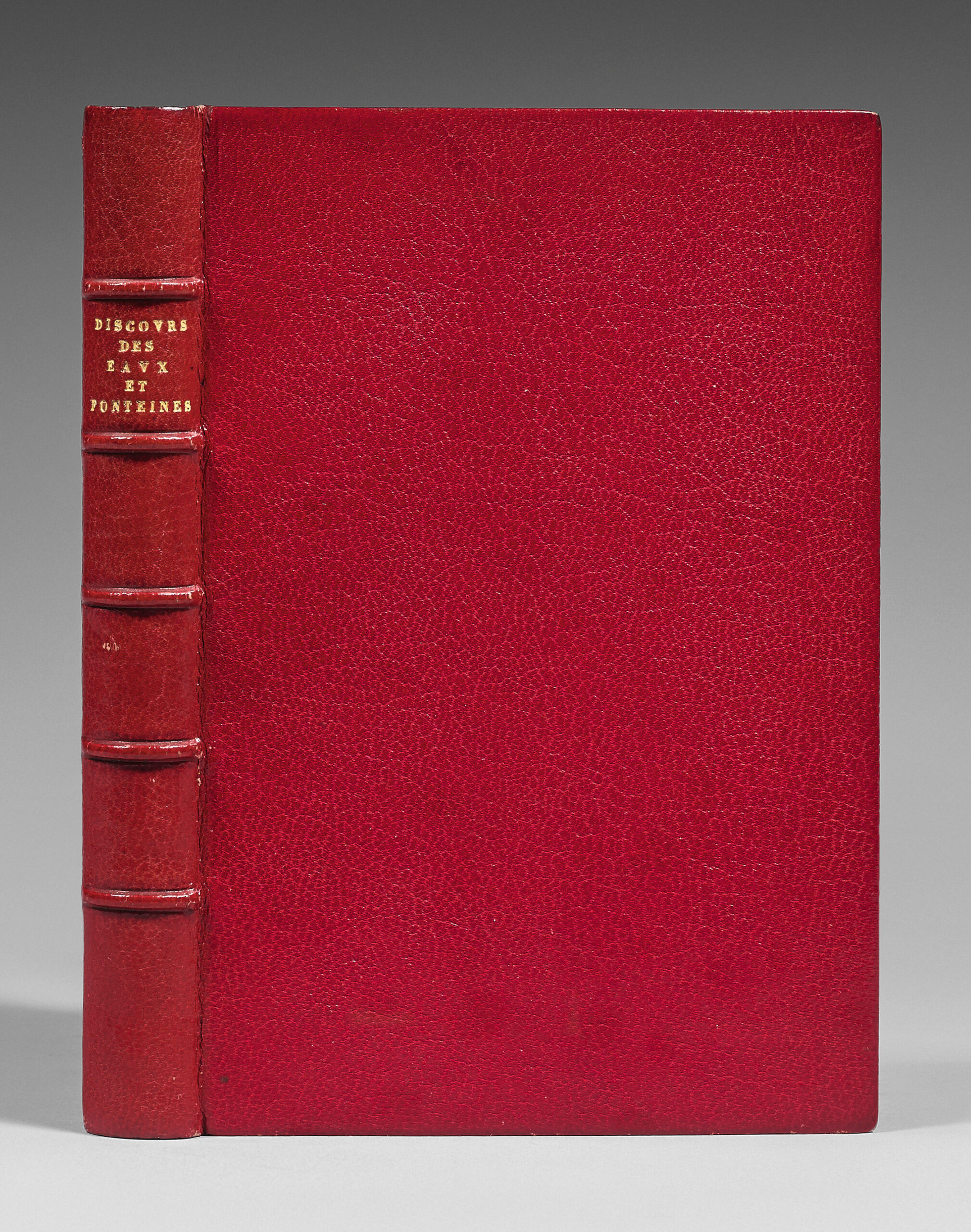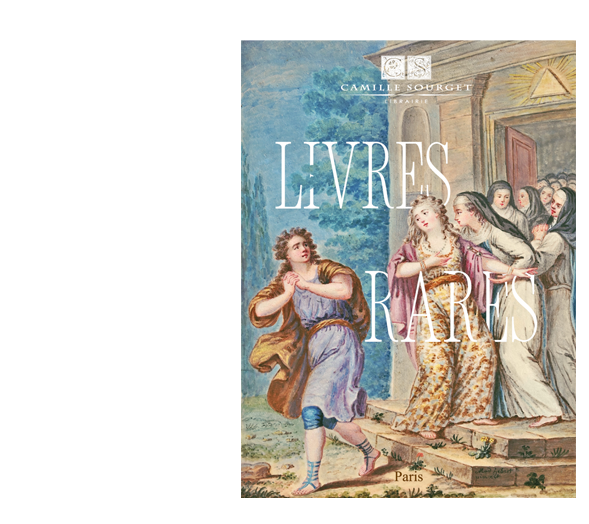Paris, Chez Martin le Ieune, à l’enfeigne du Serpent, deuant le college de Cambray, 1580.
8vo of (8) ll., 361 pp., (23) pp. of table. Ext. margin of the title-page restored not touching the text. Full red Jansenist morocco, spine ribbed, gilt edges. Binding signed by Trautz-Bauzonnet.
156 x 106 mm.
“First edition of a piece as interesting as rare“. (Brunet, supplement, VIII, 133).
B.n.F., En Français dans le texte, n°72 ; Neville, Historical chemical Library, 2006, p. 250 ; Duveen, Bibliotheca alchemica et chemica, p. 446 : “A book of great importance in the history of chemistry and science generally. Extremely rare.”
A great book of science in the sixteenth century.
Exemplary figure of the self-taught man, Bernard Palissy (1510-1590) advocated observation and the virtues of the experimental method.
Palissy, “one of the men of genius of whom France is proud”, was born at the beginning of the sixteenth century in the village of La Capelle-Biron, in the diocese of Agen. A remarkable hydraulic engineer and brilliant ceramist, Palissy designed mysterious caves populated by ceramic characters or animals where water circulated, no doubt animating what he called his “rustic figulines”. The Constable then had Catherine de Medici award him the title of “Inventeur des rustiques figulines du Roy et de la Royne sa mere.”
Palissy’s first book was published in 1563.
The privileged position he occupied in a royal residence meant that on 24 August 1572 he was spared in the midst of the St Bartholomew’s Day massacres. Like Ambroise Paré, he only escaped this horrible slaughter because he was in the Louvre, where he was protected by the inviolable majesty and perhaps also the fearful egotism of the king. An ardent Huguenot, he died in the Bastille in his eighties and in misery, refusing to abjure.
The second work of Palissy, much more considerable than the first, is entitled: Discours admirables de la nature des eaux et fontaines, tant naturelles qu’artificielles, etc. ; one 8vo volume, Paris, chez Martin le jeune, à l’enseigne du Serpent, devant le collège de Cambray, 1580. This book is dedicated to the Sire de Pont, one of his former patrons. The order gives way to the irregularity that we noticed in the previous volume. The theories are well coordinated, with the exception of the Traité de l’art de la terre, where Palissy recounts his tireless efforts to discover enamel. The eleven treatises that make up this second work provide the best overview of the scientific work he carried out; they are arranged in the following order: 1° Des eaux, des fleuves, fontaines, puits, citernes, estangs, marez et autres eaux douces ; de leur origine, bonté ; mauvaiseté et aultres qualitez ; avec le moyen de faire des fontaines en tout lieu ; 2° De l’alchimie, des métaux, de leur génération et nature ; 3° De l’or potable ; 4° Du mithridat ; 5° Des glaces ; 6° Des diverses sortes de sels végétatifs ou génératifs et soustenans les formes, en la génération de ces corps terrestres, de leur nature et merveilleux effets ; 7° Du sel commun, la manière de le faire, avec la description des marez salants ; 8° Des pierres tant communes que précieuses ; des causes de leur génération ; des diverses formes, couleurs, pesanteur, dureté, transparence et autres qualités d’icelles ; 9° Des diverses sortes d’argilles, natures et effets d’icelles ; 10° De l’art de terre, de son utilité, des émaux et du feu ; 10° De la marne et de son utilité, avec le moyen de la connaistre et en trouver en toute province.
The present collection of eleven treatises deals with alchemy, which he mocks with wit, and hydrology, where he formulates a true theory of springs. He was an agronomist and defended the use of marl (a sedimentary rock) to improve the land and protested against deforestation. A geologist before his time, he also studied fossils, and guessed that there were extinct species “of which we see no more”.
This book, which deals with the origin of fountains, the formation of fossil stones and shells, the means of purifying water, the usefulness of marl in agriculture, is, according to Duveen’s assessment: “Extremely rare and a book of great importance in the history of chemistry and science generally”.
But the book remains famous mainly for the description of his research on glazed ceramics. To achieve this, Palissy had to make sixteen years of unprecedented sacrifices and toil, going so far as to burn his furniture to ensure the heating of his furnaces. The powerful were immediately interested in his discovery and the Constable Anne de Montmorency asked him to build a cave near his castle.
“Advances in physical sciences having manifested themselves in a happy manner at the beginning of the eighteenth century, the name of Palissy was acclaimed by Buffon, Fontenelle, Jussieu and all the first naturalists, who recognized him as the precursor of their ideas.”
A precious copy of this rare first edition.
The rarity of the Discours admirables was already pointed out by Brunet, confirmed by Duveen who described it as “extremely rare” and who recalls that Ferguson only found a copy “at last, after long, long waiting and watching”.



